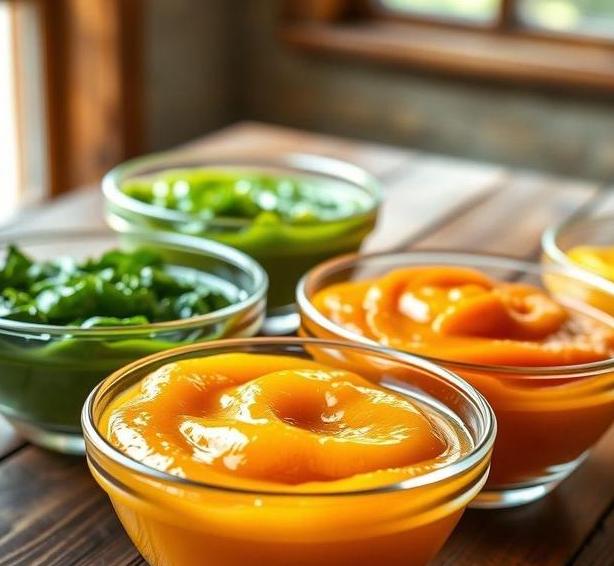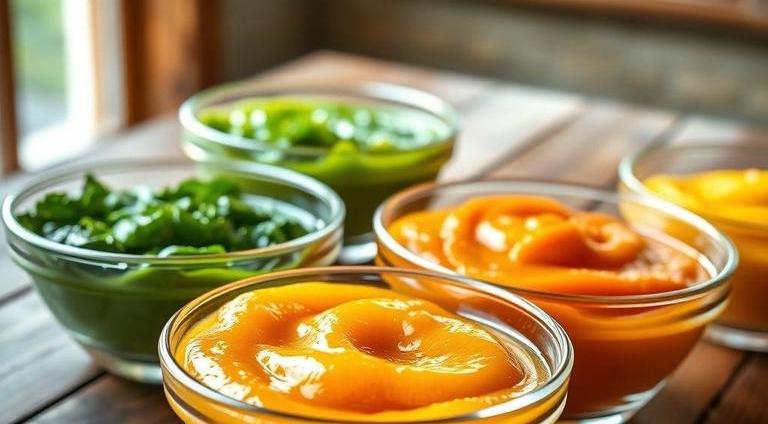Vegetable puree, the smooth and creamy concoction made by blending vegetables, is a staple in many kitchens. From baby food to soups, sauces, and even as an ingredient in baked goods, vegetable purees serve a multitude of purposes. They are not only nutritious but also add a velvety texture to dishes. However, like all food items, they have a shelf life, and it’s important to know how to store them properly to avoid spoilage and waste. Whether you’ve made a big batch of homemade puree or bought some from the store, understanding its longevity and how to keep it fresh is crucial. Let’s explore everything you need to know about vegetable puree, from spoilage signs to expert storage techniques.
Can Vegetable Puree Go Bad?
Yes, like any perishable food, vegetable puree can absolutely go bad. While it may seem like a harmless ingredient when fresh, there are several factors that can cause it to spoil over time. Since vegetable purees typically contain water and natural sugars, they provide a perfect breeding ground for bacteria and mold if not handled properly.
Here Are The Main Reasons It Can Spoil
- Moisture content: The high moisture content in pureed vegetables is ideal for bacterial growth, especially if the puree is stored improperly.
- No preservatives: Homemade purees, in particular, lack preservatives, which means they have a much shorter shelf life compared to their store-bought counterparts.
- Temperature fluctuations: Leaving vegetable puree out at room temperature for too long or storing it improperly can lead to rapid spoilage.
- Exposure to air: If not stored in an airtight container, exposure to air can cause oxidation, leading to off-flavors and spoilage.
In summary, vegetable purees do have a shelf life, and their freshness depends on factors like storage methods, temperature, and handling.
Shelf Life For Vegetable Puree

The shelf life of vegetable puree varies depending on whether it’s homemade or store-bought, the type of vegetable, and how it’s stored. Here’s a more detailed look:
Homemade Vegetable Puree
- In the refrigerator: Fresh homemade vegetable puree typically lasts 3 to 5 days when stored in an airtight container. The exact duration can depend on the type of vegetable used. For instance, puree made from starchy vegetables like potatoes may last a little longer compared to softer, water-rich vegetables like zucchini or tomatoes.
- In the freezer: Freezing is a great way to preserve homemade vegetable puree for longer periods. When stored properly in a freezer-safe container or plastic bag, vegetable puree can last anywhere from 6 to 12 months. Keep in mind, however, that while it remains safe to eat beyond the 12-month mark, the flavor and texture may start to degrade.
Store-Bought Vegetable Puree
- Unopened jars or pouches: If unopened, store-bought purees usually come with a long shelf life due to added preservatives and vacuum sealing. You can expect these to last up to a year or even longer when kept in a cool, dry pantry. Always check the expiration date for the most accurate info.
- Once opened: After opening, store-bought purees have a shorter lifespan. They typically last around 4 to 7 days in the fridge, so it’s best to transfer them to an airtight container after opening.
Common Signs Of Spoilage
Recognizing when vegetable puree has gone bad is key to ensuring safety. Spoiled puree may not only taste unpleasant, but consuming it can also lead to foodborne illness. Here are the most common signs of spoilage:
- Smell: One of the first indicators of spoilage is an off or sour smell. Fresh vegetable puree should have a neutral or slightly vegetable-specific aroma. If it smells rotten or fermented, it’s best to discard it.
- Color changes: Over time, the color of vegetable puree can dull or darken, indicating oxidation. If you notice that the puree has turned an unappetizing brown or grayish hue, it’s likely past its prime.
- Mold growth: If you see any mold (green, white, or black spots) growing on the surface, discard the entire batch immediately. Mold can form if the puree has been exposed to air or stored improperly.
- Separation or texture changes: While slight separation of liquid from the puree may occur (especially after freezing), if the texture becomes excessively watery or slimy, that’s a strong sign the puree has spoiled. It may also feel mushy or too thin.
- Off taste: If all else fails, taste testing is the final check. If the vegetable puree tastes sour, rancid, or strange in any way, don’t hesitate to toss it.
How To Store Vegetable Puree?

Proper storage is the key to prolonging the shelf life of vegetable puree. Here are some important guidelines to follow:
Refrigeration (For Short-Term Storage)
- Use an airtight container: After preparing or opening your vegetable puree, transfer it to a container that seals tightly to prevent air exposure. Glass containers with tight-fitting lids work best, but BPA-free plastic containers are a good alternative.
- Cool it down before storing: Allow the puree to cool to room temperature before refrigerating. Placing hot puree directly into the fridge can cause condensation and invite bacteria growth.
- Refrigerate promptly: Always refrigerate your puree within two hours of preparation to reduce the risk of bacterial contamination.
Freezing (For Long-Term Storage)
- Portion it out: If you make large batches, portion your puree into smaller servings before freezing. This makes it easier to defrost only what you need, preventing waste.
- Use freezer-safe bags or containers: A good option for freezing vegetable puree is to use freezer-safe plastic bags, which allow you to squeeze out excess air. Alternatively, use airtight freezer-safe containers.
- Leave space for expansion: Liquids expand when frozen, so leave some room at the top of your container or bag to avoid any mess or breakage.
- Label and date: Always label your containers with the date of freezing to help you keep track of how long it’s been stored.
Expert Tips
To maximize the freshness and flavor of your vegetable puree, consider these expert tips:
- Blanch vegetables before pureeing: Blanching (briefly boiling and then cooling vegetables) helps to lock in flavor and nutrients while also extending the shelf life of your puree.
- Avoid adding salt or dairy if freezing: Salt and dairy can change the texture of the puree after freezing. It’s best to add these ingredients after thawing the puree.
- Reheat properly: If you’re reheating frozen puree, do so slowly on the stove over low heat to prevent the texture from changing too drastically.
- Add lemon juice or vinegar for preservation: A small amount of acid, such as lemon juice or vinegar, can help preserve the color and freshness of the puree while also adding a pleasant flavor.
FAQs
Can Vegetable Puree Go Bad If Left Out At Room Temperature?
Yes, vegetable puree can go bad if left out at room temperature for an extended period. Bacteria and mold can grow in the puree, especially if it contains moisture. It is recommended to refrigerate or freeze vegetable puree within two hours of preparation.
How Long Does Vegetable Puree Last In The Fridge?
Vegetable puree typically lasts 3 to 5 days in the refrigerator if stored in an airtight container. After this period, it may begin to spoil, and its quality will degrade.
Can I Store Vegetable Puree In The Freezer?
Yes, you can store vegetable puree in the freezer. It can last up to 6 months when properly stored in an airtight container or freezer-safe bag. Freezing preserves the puree, but the texture may change slightly upon thawing.
What Signs Should I Look For To Know If Vegetable Puree Has Gone Bad?
Signs that vegetable puree has gone bad include a sour or off smell, discoloration (such as browning), mold growth, and a change in texture, such as becoming overly watery or slimy.
Can I Eat Vegetable Puree After The Expiration Date?
While vegetable puree may still be safe to consume shortly after its expiration date, it’s important to check for any signs of spoilage, such as off smells or mold. It’s always safer to err on the side of caution.
How Can I Prevent Vegetable Puree From Spoiling?
To prevent vegetable puree from spoiling, refrigerate or freeze it promptly after cooking. Ensure the container is airtight and store it in small portions to minimize exposure to air. Avoid leaving it out at room temperature for more than two hours.
Can Vegetable Puree Spoil Faster In Certain Conditions?
Yes, vegetable puree may spoil faster in warm and humid conditions, as bacteria thrive in such environments. Proper cooling and refrigeration are essential for slowing down the spoilage process.
Can Vegetable Puree Go Bad If It Has Been Blended With Other Ingredients?
Blending vegetable puree with other ingredients such as cream, dairy, or oil can shorten its shelf life. These ingredients may spoil more quickly than the vegetable puree itself. Be sure to check the expiry date of any added ingredients and store the mixture properly.
How Can I Tell If Frozen Vegetable Puree Has Gone Bad?
If frozen vegetable puree has gone bad, it may have freezer burn, which appears as dry, discolored patches on the surface. If the puree smells rancid or has a strange texture when thawed, it may be unsafe to eat.
Can Vegetable Puree Be Safely Reheated After Freezing?
Yes, vegetable puree can be safely reheated after freezing. Thaw it in the refrigerator overnight or use a microwave or stovetop to reheat. Ensure it’s heated to a safe temperature (above 165°F or 74°C) to kill any potential bacteria.